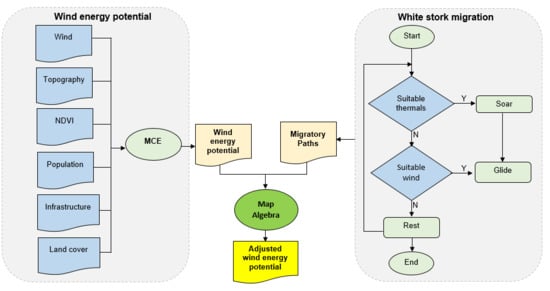Predicting Migratory Corridors of White Storks, Ciconia ciconia, to Enhance Sustainable Wind Energy Planning: A Data-Driven Agent-Based Model
Abstract
1. Introduction
1.1. Background
1.2. Related Work
1.3. Research Objectives
2. Materials and Methods
2.1. Study Area
2.2. Data Sources and Pre-Processing
2.3. Model Specification
2.3.1. Model Purpose
2.3.2. Model Entities, State Variables, and Scales
- S0 instantaneous step length,
- E1 E7; environmental variables
- t0 instantaneous turn angle
- C1 random value representing intercept of linear function for step length
- C2 random value representing intercept of the linear function for turn angle
- f1; f14 random values to represent co-efficient of environmental variables. We used the first seven values to estimate step distance and the seven to estimate turn angles.
2.3.3. Process Overview and Scheduling
2.3.4. Design Concepts
- Emergence: From the individual white stork agent behaviors and interactions of the agent with its local environment, we were interested in the emergence of plausible trajectories. Furthermore, from the autonomous decisions of agents, we were interested in the system-level migratory corridors that emerged from the patch occupancy by the different agents.
- Adaptation: Bird agents adapted to their environment by, for instance, avoiding water bodies, soaring at patches with suitable thermals, and gliding when they had suitable flying heights that could facilitate the gliding and resting when the patch was neither suitable for soaring nor gliding.
- Sensing: Bird agents could perceive the differences in elevation, thermal characteristics, and water bodies. When elevation and thermals were suitable, birds soared and glided, and when the birds were closer to water bodies, they chose dry patches in their vicinity to fly to.
2.3.5. Model Output
2.4. Mapping Wind Energy Potential
2.5. Predicting Migratory Corridors of White Storks
2.6. Incorporating the Influence of Proximity to Predicted Migratory Corridors on Wind Energy Potential
3. Results
3.1. Flight Behavior of the Migratory White Storks
3.2. Wind Energy Potential from Classical Multi-Criteria Evaluation
3.3. Migratory Corridor of Simulated Birds
3.4. Wind Energy Potential Surface and Potential Collission Risk
4. Discussion
4.1. GNSS Tracking and Behavior Mapping
4.2. Dynamic Agent-Based Modeling for Space-Time Mapping
4.3. Emergence of Patterns from White Stork Agent Behaviors
4.4. Limitations and Future Research Directions
5. Conclusions
Supplementary Materials
Author Contributions
Acknowledgments
Conflicts of Interest
References
- Vansteelant, W.M.G.; Shamoun-Baranes, J.; McLaren, J.; van Diermen, J.; Bouten, W. Soaring across continents: Decision-making of a soaring migrant under changing atmospheric conditions along an entire flyway. J. Avian Biol. 2017, 48, 887–896. [Google Scholar] [CrossRef]
- Shamoun-Baranes, J.; Leshem, Y.; Yom-Tov, Y.; Liechti, O. Differential Use of Thermal Convection by Soaring Birds over Central Israel. Condor 2003, 105, 208–218. [Google Scholar] [CrossRef]
- Zwart, M.C.; McKenzie, A.J.; Minderman, J.; Whittingham, M.J. Conflicts between birds and on-shore wind farms. In Problematic Wildlife; Springer: Berlin/Heidelberg, Germany, 2016; pp. 489–504. [Google Scholar]
- Winkelman, J. Birds and the wind park near Urk: Collision victims and disturbance of ducks, geese, and swans. RIN Rep. 1989, 89, 117–121. [Google Scholar]
- Barrios, L.; Rodríguez, A. Behavioural and environmental correlates of soaring-bird mortality at on-shore wind turbines. J. Appl. Ecol. 2004, 41, 72–81. [Google Scholar] [CrossRef]
- Drewitt, A.L.; Langston, R.H.W. Assessing the impacts of wind farms on birds. Ibis 2006, 148, 29–42. [Google Scholar] [CrossRef]
- Orloff, S.; Flannery, A. Wind Turbine Effects on Avian Activity, Habitat Use, and Mortality in Altamont Pass and Solano Country Wind Resource Areas: 1989–1991; Final Report; Biosystems Analysis: Alameda, CA, USA, 1992. [Google Scholar]
- Evans Ogden, L.J. Collision Course: The Hazards of Lighted Structures and Windows to Migrating Birds; World Wildlife Fund Canada and the Fatal Light Awareness Program: Toronto, ON, Canada, 1996. [Google Scholar]
- Liechti, F.; Ehrich, D.; Bruderer, B. Flight Behaviour of White Storks Ciconia Ciconia on Their Migration over Southern Israël. ARDEA 1996, 84, 3–11. [Google Scholar]
- Thelander, C.G.; Smallwood, K.S.; Rugge, L. Bird Risk Behaviors and Fatalities at the Altamont Pass Wind Resource Area: Period of Performance, March 1998–December 2000; National Renewable Energy Lab.: Golden, CO, USA, 2003. [Google Scholar]
- Pearce-Higgins, J.W.; Stephen, L.; Langston, R.H.; Bainbridge, I.P.; Bullman, R. The distribution of breeding birds around upland wind farms. J. Appl. Ecol. 2009, 46, 1323–1331. [Google Scholar] [CrossRef]
- Smallwood, K.S. Estimating wind turbine–caused bird mortality. J. Wildl. Manag. 2007, 71, 2781–2791. [Google Scholar] [CrossRef]
- Finlayson, C. Birds of the Strait of Gibraltar; Bloomsbury Publishing: London, UK, 2010. [Google Scholar]
- García, J.T.; Arroyo, B.E. Migratory movements of western European Montagu’s Harrier Circus pygargus: A review. Bird Study 1998, 45, 188–194. [Google Scholar] [CrossRef]
- Leshem, Y.; Yom-Tov, Y. Routes of migrating soaring birds. Ibis 1998, 140, 41–52. [Google Scholar] [CrossRef]
- Tsovel, A.; Allon, D. Soaring bird migration survey in the northern valleys of Israel, autumns 1988–90. In Raptors in Israel: Passage and Wintering Populations; International Birdwatching Center: Eilat, Israel, 1991; pp. 31–45. [Google Scholar]
- Mukasa, A.D.; Mutambatsere, E.; Arvanitis, Y.; Triki, T. 9 Development of Wind Energy in Africa. Incl. Growth Afr. Policies Pract. Lessons Learn. 2016, 23, 185. [Google Scholar]
- Mentis, D.; Howells, M.; Rogner, H.; Korkovelos, A.; Arderne, C.; Zepeda, E.; Siyal, S.; Taliotis, C.; Bazilian, M.; de Roo, A. Lighting the World: The first application of an open source, spatial electrification tool (OnSSET) on Sub-Saharan Africa. Environ. Res. Lett. 2017, 12, 085003. [Google Scholar] [CrossRef]
- Mentis, D.; Hermann, S.; Howells, M.; Welsch, M.; Siyal, S.H. Assessing the technical wind energy potential in Africa a GIS-based approach. Renew. Energy 2015, 83, 110–125. [Google Scholar] [CrossRef]
- Mentis, D.; Welsch, M.; Nerini, F.F.; Broad, O.; Howells, M.; Bazilian, M.; Rogner, H. A GIS-based approach for electrification planning—A case study on Nigeria. Energy Sustain. Dev. 2015, 29, 142–150. [Google Scholar] [CrossRef]
- Shata, A.A.; Hanitsch, R. Evaluation of wind energy potential and electricity generation on the coast of Mediterranean Sea in Egypt. Renew. Energy 2006, 31, 1183–1202. [Google Scholar] [CrossRef]
- Pegels, A. Renewable energy in South Africa: Potentials, barriers and options for support. Energy Policy 2010, 38, 4945–4954. [Google Scholar] [CrossRef]
- Gove, B.; Langston, R.; McCluskie, A.; Pullan, J.; Scrase, I. Wind Farms and Birds: An Updated Analysis of the Effects of Wind Farms on Birds, and Best Practice Guidance on Integrated Planning and Impact Assessment; BirdLife International: Cambridge, UK, 2013. [Google Scholar]
- New, L.; Bjerre, E.; Millsap, B.; Otto, M.C.; Runge, M.C. A Collision Risk Model to Predict Avian Fatalities at Wind Facilities: An Example Using Golden Eagles, Aquila chrysaetos. PLoS ONE 2015, 10, e0130978. [Google Scholar] [CrossRef] [PubMed]
- Grimm, V.; Railsback, S.F. Individual-Based Modeling and Ecology; Princeton University Press: Princeton, NJ, USA, 2013. [Google Scholar]
- Breckling, B.; Middelhoff, U.; Reuter, H. Individual-based models as tools for ecological theory and application: Understanding the emergence of organisational properties in ecological systems. Ecol. Model. 2006, 194, 102–113. [Google Scholar] [CrossRef]
- Van Loon, E.E.; Shamoun-Baranes, J.; Bouten, W.; Davis, S.L. Understanding soaring bird migration through interactions and decisions at the individual level. J. Theor. Biol. 2011, 270, 112–126. [Google Scholar] [CrossRef] [PubMed]
- Dennhardt, A.J.; Duerr, A.E.; Brandes, D.; Katzner, T.E. Modeling autumn migration of a rare soaring raptor identifies new movement corridors in central Appalachia. Ecol. Model. 2015, 303, 19–29. [Google Scholar] [CrossRef]
- Zurell, D.; Eggers, U.; Kaatz, M.; Rotics, S.; Sapir, N.; Wikelski, M.; Nathan, R.; Jeltsch, F. Individual-based modelling of resource competition to predict density-dependent population dynamics: A case study with white storks. Oikos 2015, 124, 319–330. [Google Scholar] [CrossRef]
- Band, W.; Madders, M.; Whitfield, D.P. Developing field and analytical methods to assess avian collision risk at wind farms. In Birds and Wind Farms: Risk Assessment and Mitigation; Scottish National Heritage: Perth, UK, 2007; pp. 259–275. [Google Scholar]
- Whitfield, D.P.; Madders, M. Deriving Collision Avoidance Rates for Red Kites Milvus. In Natural Research Information Note; Natural Research Ltd.: Banchory, UK, 2006. [Google Scholar]
- Eichhorn, M.; Johst, K.; Seppelt, R.; Drechsler, M. Model-Based Estimation of Collision Risks of Predatory Birds with Wind Turbines. Ecol. Soc. 2012, 17, 1. [Google Scholar] [CrossRef]
- Santos, M.; Bastos, R.; Ferreira, D.; Santos, A.; Barros, P.; Travassos, P.; Carvalho, D.; Gomes, C.; Vale-Gonçalves, H.M.; Braz, L.; et al. A spatial explicit agent based model approach to evaluate the performance of different monitoring options for mortality estimates in the scope of onshore windfarm impact assessments. Ecol. Indic. 2017, 73, 254–263. [Google Scholar] [CrossRef]
- DeAngelis, D.L.; Grimm, V. Individual-based models in ecology after four decades. F1000prime Rep. 2014, 6, 39. [Google Scholar] [CrossRef] [PubMed]
- Nittel, S. A Survey of Geosensor Networks: Advances in Dynamic Environmental Monitoring. Sensors 2009, 9, 5664–5678. [Google Scholar] [CrossRef] [PubMed]
- Dodge, S.; Bohrer, G.; Weinzierl, R.; Davidson, S.C.; Kays, R.; Douglas, D.; Cruz, S.; Han, J.; Brandes, D.; Wikelski, M. The environmental-data automated track annotation (Env-DATA) system: Linking animal tracks with environmental data. Mov. Ecol. 2013, 1, 3. [Google Scholar] [CrossRef] [PubMed]
- Keller, N.; Xiaolin, H. Data driven simulation modeling for mobile agent-based systems. In Proceedings of the 2016 Symposium on Theory of Modeling and Simulation (TMS-DEVS), Pasadena, CA, USA, 3–6 April 2016; pp. 1–8. [Google Scholar]
- Srinivas, M.; Patnaik, L.M. Genetic algorithms: A survey. Computer 1994, 27, 17–26. [Google Scholar] [CrossRef]
- Calvez, B.; Hutzler, G. Automatic tuning of agent-based models using genetic algorithms. In International Workshop on Multi-Agent Systems and Agent-Based Simulation; Springer: Berlin/Heidelberg, Germany, 2005. [Google Scholar]
- Stonedahl, F.; Wilensky, U. Finding Forms of flocking: Evolutionary search in abm parameter-spaces. In International Workshop on Multi-Agent Systems and Agent-Based Simulation; Springer: Berlin/Heidelberg, Germany, 2010. [Google Scholar]
- Jebari, K.; Madiafi, M. Selection methods for genetic algorithms. Int. J. Emerg. Sci. 2013, 3, 333–344. [Google Scholar]
- Kirby, J.S.; Stattersfield, A.J.; Butchart, S.H.M.; Evans, M.I.; Grimmett, R.F.A.; Jones, V.R.; O’Sullivan, J.; Tucker, G.M.; Newton, I. Key conservation issues for migratory land- and waterbird species on the world’s major flyways. Bird Conserv. Int. 2008, 18, S49–S73. [Google Scholar] [CrossRef]
- International Renewable Energy Agency (IRENA). Unlocking Renewable Energy Investment: The Role of Risk Mitigation and Structured Finance; IRENA: Abu Dhabi, UAE, 2016; pp. 54–55. [Google Scholar]
- Dee, D.P.; Uppala, S.; Simmons, A.; Berrisford, P.; Poli, P.; Kobayashi, S.; Andrae, U.; Balmaseda, M.; Balsamo, G.; Bauer, P. The ERA-Interim reanalysis: Configuration and performance of the data assimilation system. Q. J. R. Meteorol. Soc. 2011, 137, 553–597. [Google Scholar] [CrossRef]
- Flack, A.; Fiedler, W.; Blas, J.; Pokrovski, I.; Mitropolsky, B.; Kaatz, M.; Aghababyan, K.; Khachatryan, A.; Fakriadis, I.; Makrigianni, E.; et al. Data from: Costs of Migratory Decisions: A Comparison across Eight White Stork Populations; Movebank Data Repository: Radolfzell, Germany, 2015. [Google Scholar]
- Flack, A.; Fiedler, W.; Blas, J.; Pokrovsky, I.; Kaatz, M.; Mitropolsky, M.; Aghababyan, K.; Fakriadis, I.; Makrigianni, E.; Jerzak, L.; et al. Costs of migratory decisions: A comparison across eight white stork populations. Sci. Adv. 2016, 2, e1500931. [Google Scholar] [CrossRef] [PubMed]
- Jenness, J.; Dooley, J.; Aguilar-Manjarrez, J. GIS-Based Tools for Inland Aquatic Resource Management; Africa Water Resource Database: Rome, Italy, 2007. [Google Scholar]
- Swets, D.L. A weighted least-squares approach to temporal smoothing of NDVI. In Proceedings of the 1999 Annual Conference of American Society for Photogrammetry and Remote Sensing, Portland, OR, USA, 17–21 May 1999. [Google Scholar]
- Bontemps, S.; Defourny, P.; Bogaert, E.V.; Arino, O.; Kalogirou, V.; Perez, J.R. GLOBCOVER 2009-Products Description and Validation Report; European Space Agency (ESA): Paris, France, 2011. [Google Scholar]
- Linard, C.; Gilbert, M.; Snow, R.W.; Noor, A.M.; Tatem, A.J. Population distribution, settlement patterns and accessibility across Africa in 2010. PLoS ONE 2012, 7, e31743. [Google Scholar] [CrossRef] [PubMed]
- Lehner, B.; Döll, P. Development and validation of a global database of lakes, reservoirs and wetlands. J. Hydrol. 2004, 296, 1–22. [Google Scholar] [CrossRef]
- Weinzierl, R.; Bohrer, G.; Kranstauber, B.; Fiedler, W.; Wikelski, M.; Flack, A. Wind estimation based on thermal soaring of birds. Ecology Evol. 2016, 6, 8706–8718. [Google Scholar] [CrossRef] [PubMed]
- Bohrer, G.; Brandes, D.; Mandel, J.T.; Bildstein, K.L.; Miller, T.A.; Lanzone, M.; Katzner, T.; Maisonneuve, C.; Tremblay, J.A. Estimating updraft velocity components over large spatial scales: Contrasting migration strategies of golden eagles and turkey vultures. Ecol. Lett. 2012, 15, 96–103. [Google Scholar] [CrossRef] [PubMed]
- Garriga, J.; Bartumeus, F. Generating the Results with the EMbC R-Package. Available online: http://journals.plos.org/plosone/article/file?id=info%3Adoi/10.1371/journal.pone.0151984.s002&type=supplementary (accessed on 30 April 2018).
- Grimm, V.; Berger, U.; DeAngelis, D.L.; Polhill, J.G.; Giske, J.; Railsback, S.F. The ODD protocol: A review and first update. Ecol. Model. 2010, 221, 2760–2768. [Google Scholar] [CrossRef]
- Van den Bossche, W.; Berthold, P.; Kaatz, M.; Nowak, E.; Querner, U. Eastern European White Stork Populations: Migration Studies and Elaboration of Conservation Measures; Bundesamt für Naturschutz (BfN)/German Federal Agency for Nature Conservation: Bonn, Germany, 2002. [Google Scholar]
- Garriga, J.; Palmer, J.R.B.; Oltra, A.; Bartumeus, F. Expectation-Maximization Binary Clustering for Behavioural Annotation. PLoS ONE 2016, 11, e0151984. [Google Scholar] [CrossRef] [PubMed]
- Miller, A.; Li, R. A geospatial approach for prioritizing wind farm development in Northeast Nebraska, USA. ISPRS Int. J. Geo-Inf. 2014, 3, 968–979. [Google Scholar] [CrossRef]
- Yang, Z. Using GIS to Determine Wind Energy Potential in Minnesota, USA; Department of Resource Analysis, Saint Mary’s University of Minnesota: Winona, MN, USA, 2013; Volume 15, pp. 1–13. [Google Scholar]
- Rodman, L.C.; Meentemeyer, R.K. A geographic analysis of wind turbine placement in Northern California. Energy Policy 2006, 34, 2137–2149. [Google Scholar] [CrossRef]
- Tegou, L.-I.; Polatidis, H.; Haralambopoulos, D.A. Environmental management framework for wind farm siting: Methodology and case study. J. Environ. Manag. 2010, 91, 2134–2147. [Google Scholar] [CrossRef] [PubMed]
- Riley, S.J. Index That Quantifies Topographic Heterogeneity. Intermt. J. Sci. 1999, 5, 23–27. [Google Scholar]
- Gerdzhikov, G.; Iliev, M.; Nikolov, S.C. Study on the White Stork (Ciconia ciconia) Autumn Migration, Northeastern Bulgaria. Acta Zool. Bulg. 2014, 66, 283–292. [Google Scholar]
- Guillera-Arroita, G. Modelling of species distributions, range dynamics and communities under imperfect detection: Advances, challenges and opportunities. Ecography 2017, 40, 281–295. [Google Scholar] [CrossRef]
- Chandler, R.B.; Muths, E.; Sigafus, B.H.; Schwalbe, C.R.; Jarchow, C.J.; Hossack, B.R. Spatial occupancy models for predicting metapopulation dynamics and viability following reintroduction. J. Appl. Ecol. 2015, 52, 1325–1333. [Google Scholar] [CrossRef]
- Safi, K.; Kranstauber, B.; Weinzierl, R.; Griffin, L.; Rees, E.C.; Cabot, D.; Cruz, S.; Proaño, C.; Takekawa, J.Y.; Newman, S.H.; et al. Flying with the wind: Scale dependency of speed and direction measurements in modelling wind support in avian flight. Mov. Ecol. 2013, 1, 4. [Google Scholar] [CrossRef] [PubMed]
- Janssen, V. GNSS-based animal tracking: An indirect approach. In Proceedings of the 18th Association of Public Authority Surveyors Conference, Canberra, Australia, 12–14 March 2013. [Google Scholar]
- Brown, D.G.; Riolo, R.; Robinson, D.T.; North, M.; Rand, W. Spatial process and data models: Toward integration of agent-based models and GIS. J. Geogr. Syst. 2005, 7, 25–47. [Google Scholar] [CrossRef]
- Darema, F. Dynamic Data Driven Applications Systems: New Capabilities for Application Simulations and Measurements; Springer: Berlin/Heidelberg, Germany, 2005; pp. 610–615. [Google Scholar]
- Tang, W.; Bennett, D.A. Agent-based Modeling of Animal Movement: A Review. Geogr. Compass 2010, 4, 682–700. [Google Scholar] [CrossRef]
- Kays, R.; Crofoot, M.C.; Jetz, W.; Wikelski, M. Terrestrial animal tracking as an eye on life and planet. Science 2015, 348, aaa2478. [Google Scholar] [CrossRef] [PubMed]
- Couclelis, H. Macrostructure and microbehavior in a metropolitan area. Environ. Plan. B Plan. Des. 1989, 16, 141–154. [Google Scholar] [CrossRef]
- Bonabeau, E. Agent-based modeling: Methods and techniques for simulating human systems. Proc. Natl. Acad. Sci. USA 2002, 99, 7280–7287. [Google Scholar] [CrossRef] [PubMed]
- Miller, T.A.; Brooks, R.P.; Lanzone, M.; Brandes, D.; Cooper, J.; O’Malley, K.; Maisonneuve, C.; Tremblay, J.; Duerr, A.; Katzner, T. Assessing Risk to Birds from Industrial Wind Energy Development via Paired Resource Selection Models. Conserv. Biol. 2014, 28, 745–755. [Google Scholar] [CrossRef] [PubMed]
- Ritter, M.; Pieralli, S.; Odening, M. Neighborhood effects in wind farm performance: A regression approach. Energies 2017, 10, 365. [Google Scholar] [CrossRef]
- De Lucas, M.; Ferrer, M.; Bechard, M.J.; Muñoz, A.R. Griffon vulture mortality at wind farms in southern Spain: Distribution of fatalities and active mitigation measures. Biol. Conserv. 2012, 147, 184–189. [Google Scholar] [CrossRef]
- Arnett, E.B.; Huso, M.M.; Schirmacher, M.R.; Hayes, J.P. Altering turbine speed reduces bat mortality at wind-energy facilities. Front. Ecol. Environ. 2011, 9, 209–214. [Google Scholar] [CrossRef]
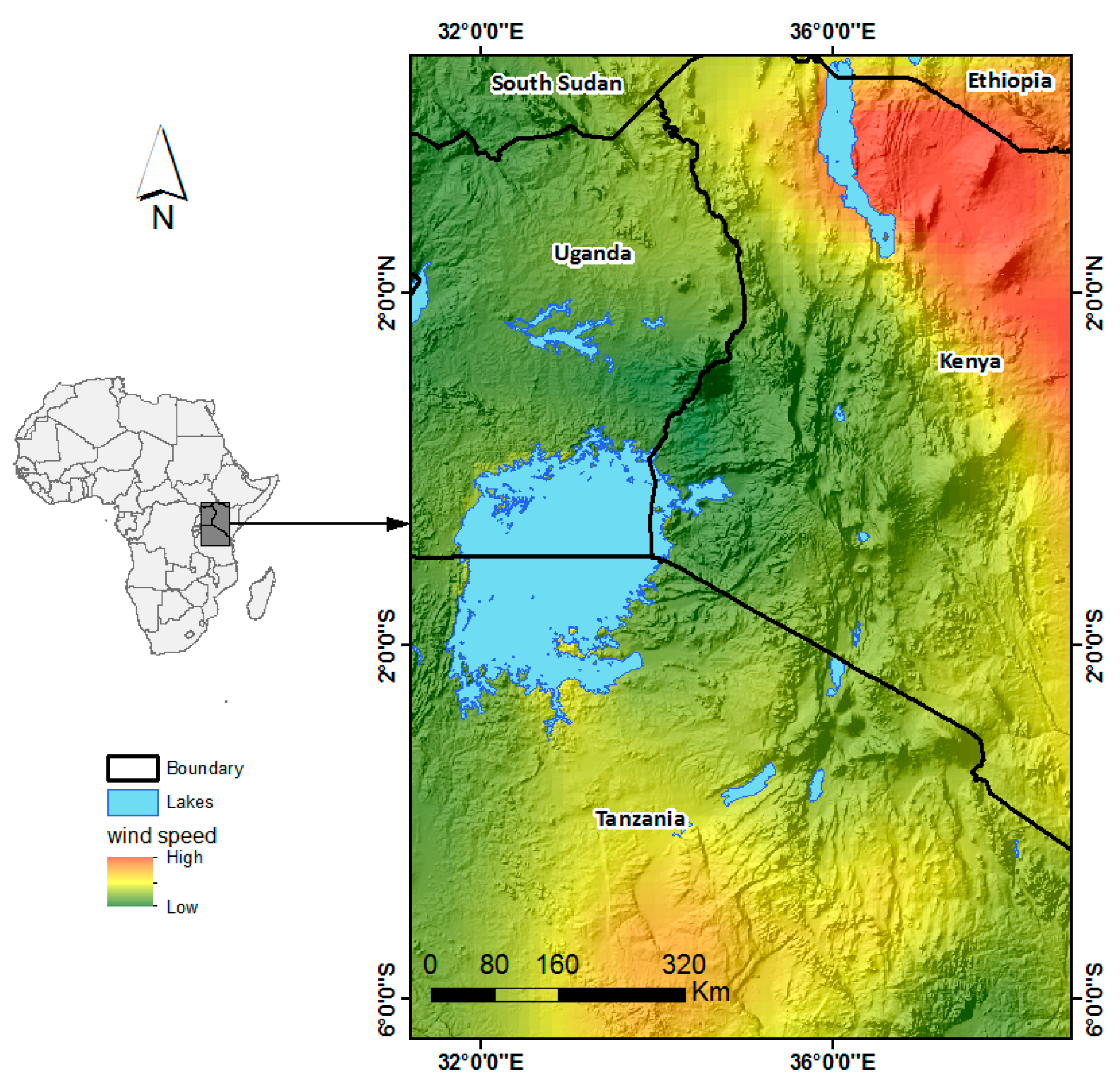
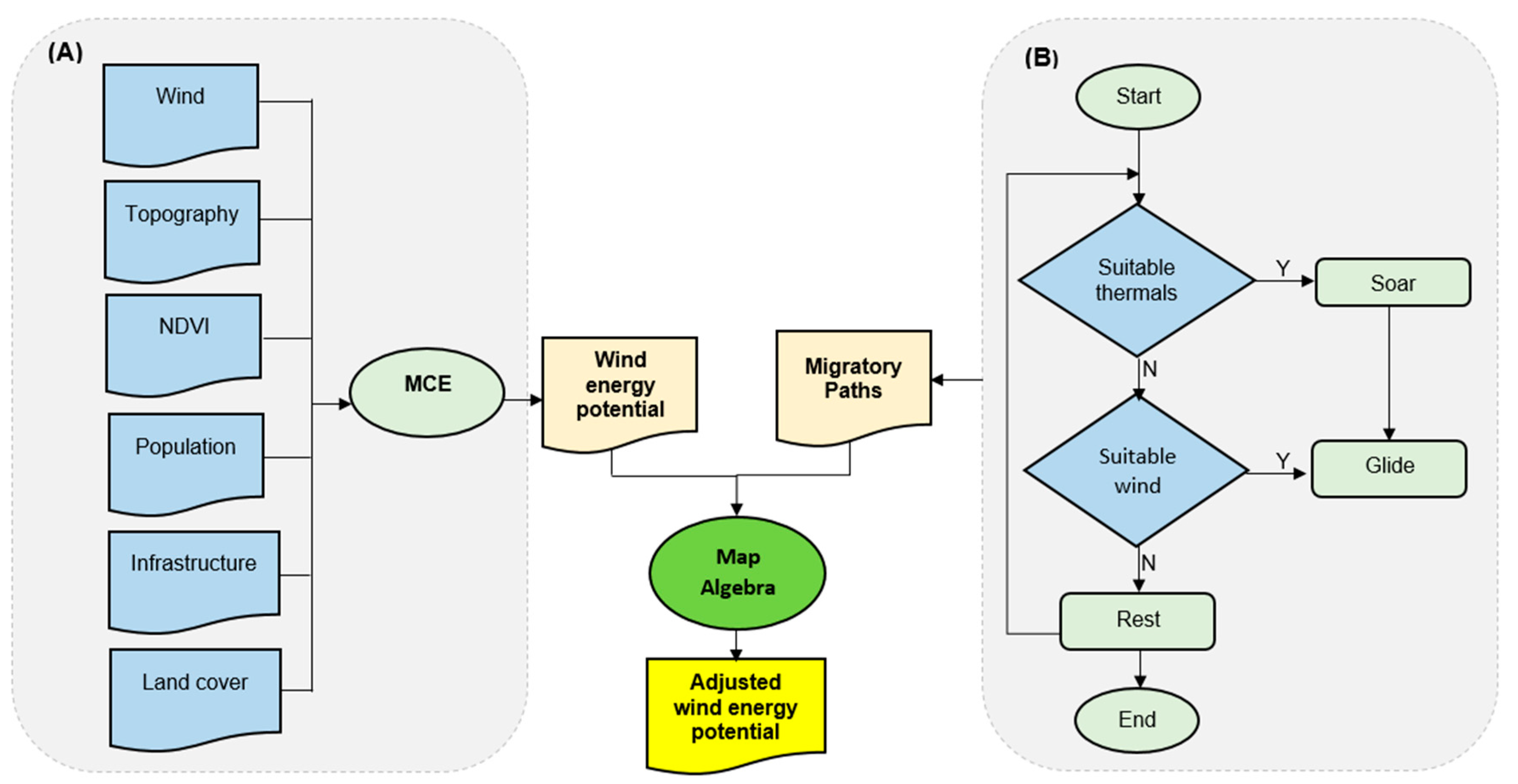
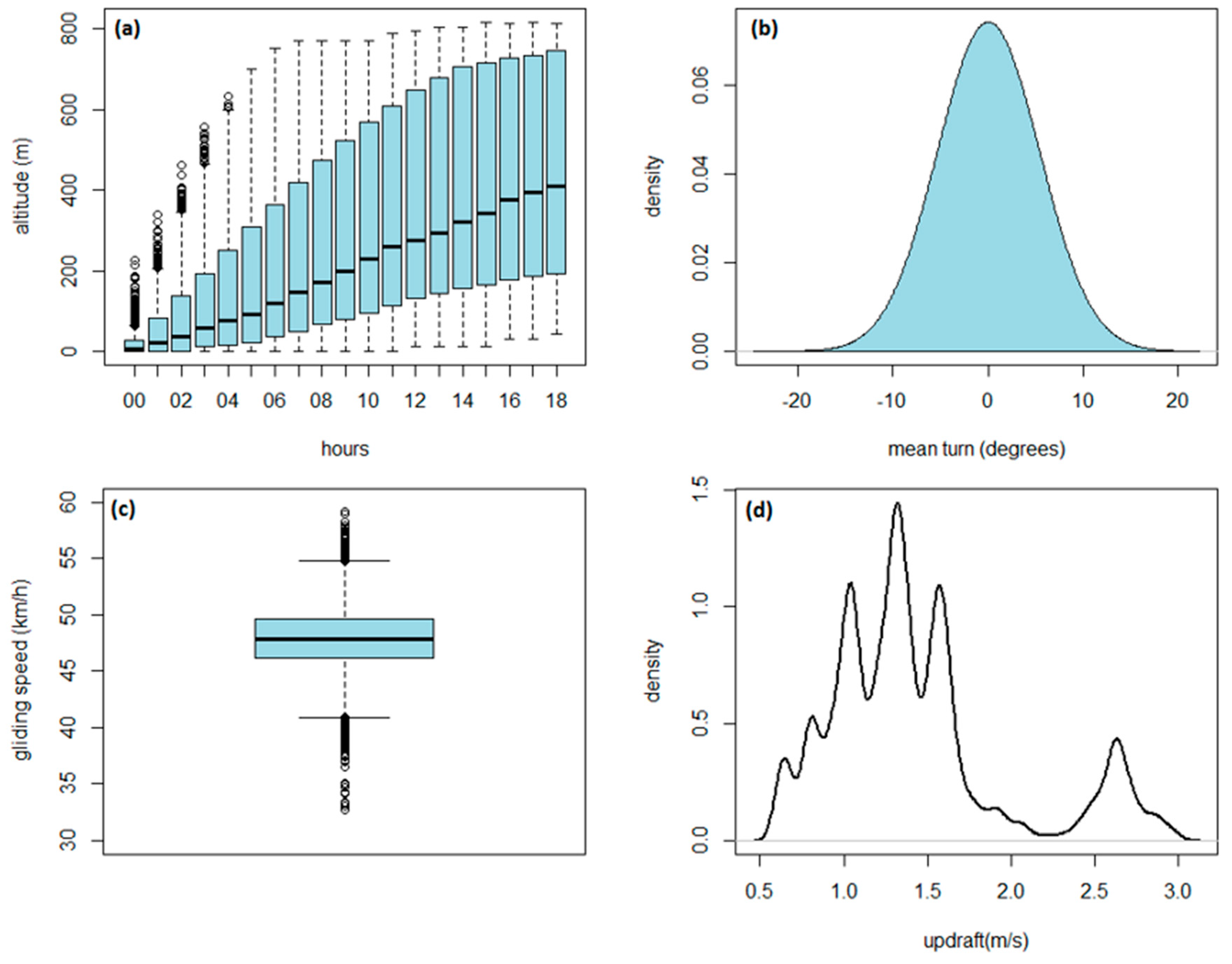
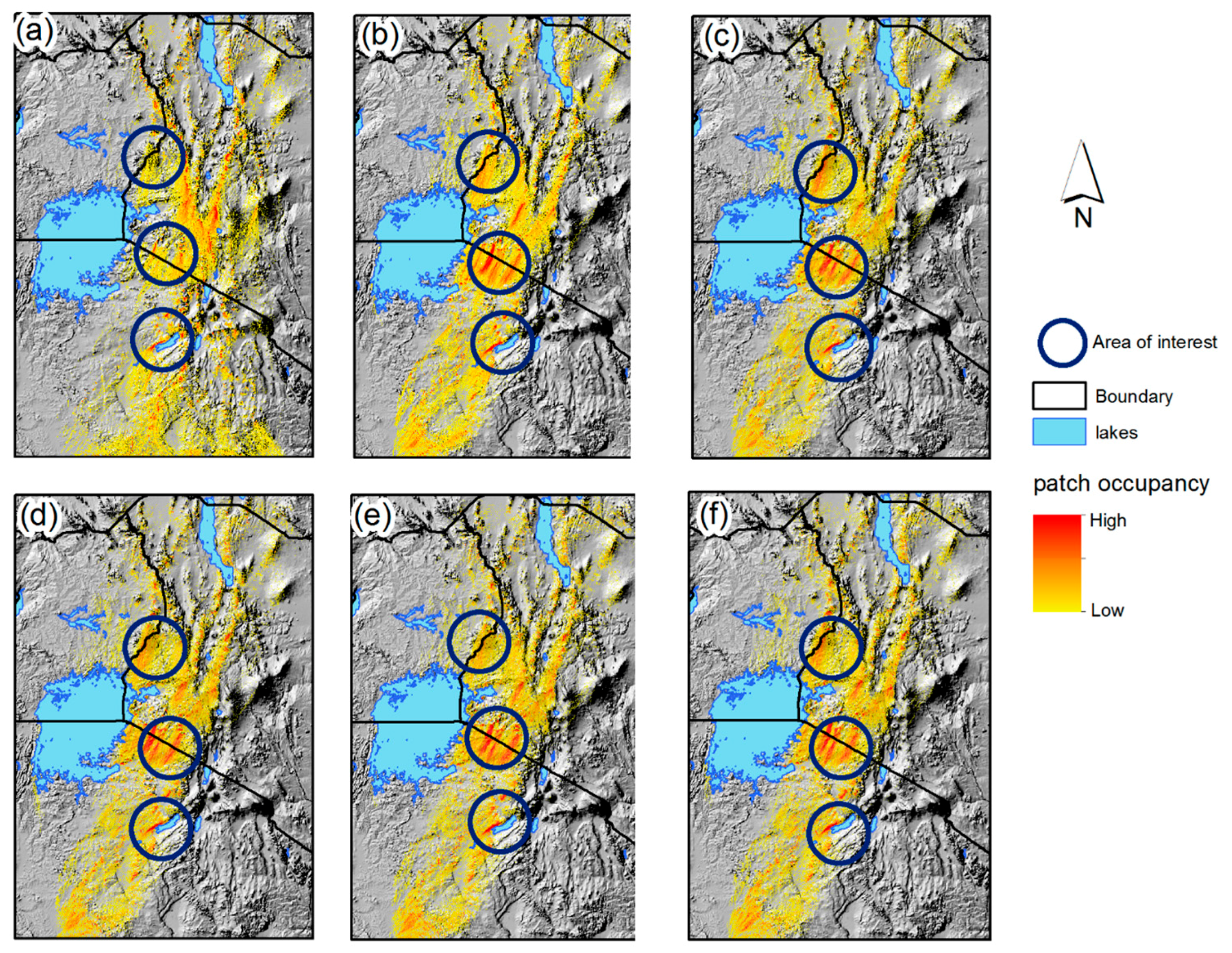
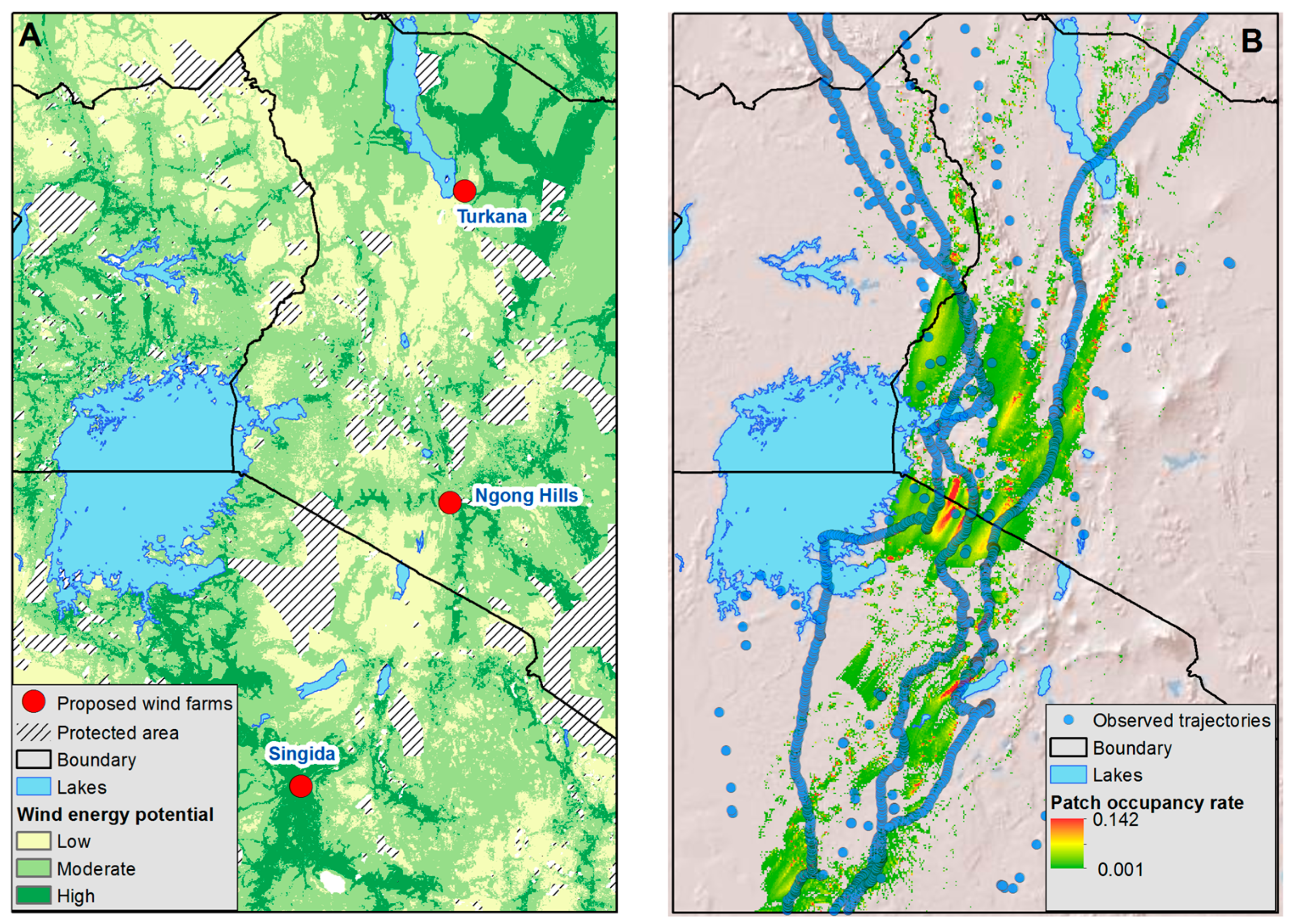
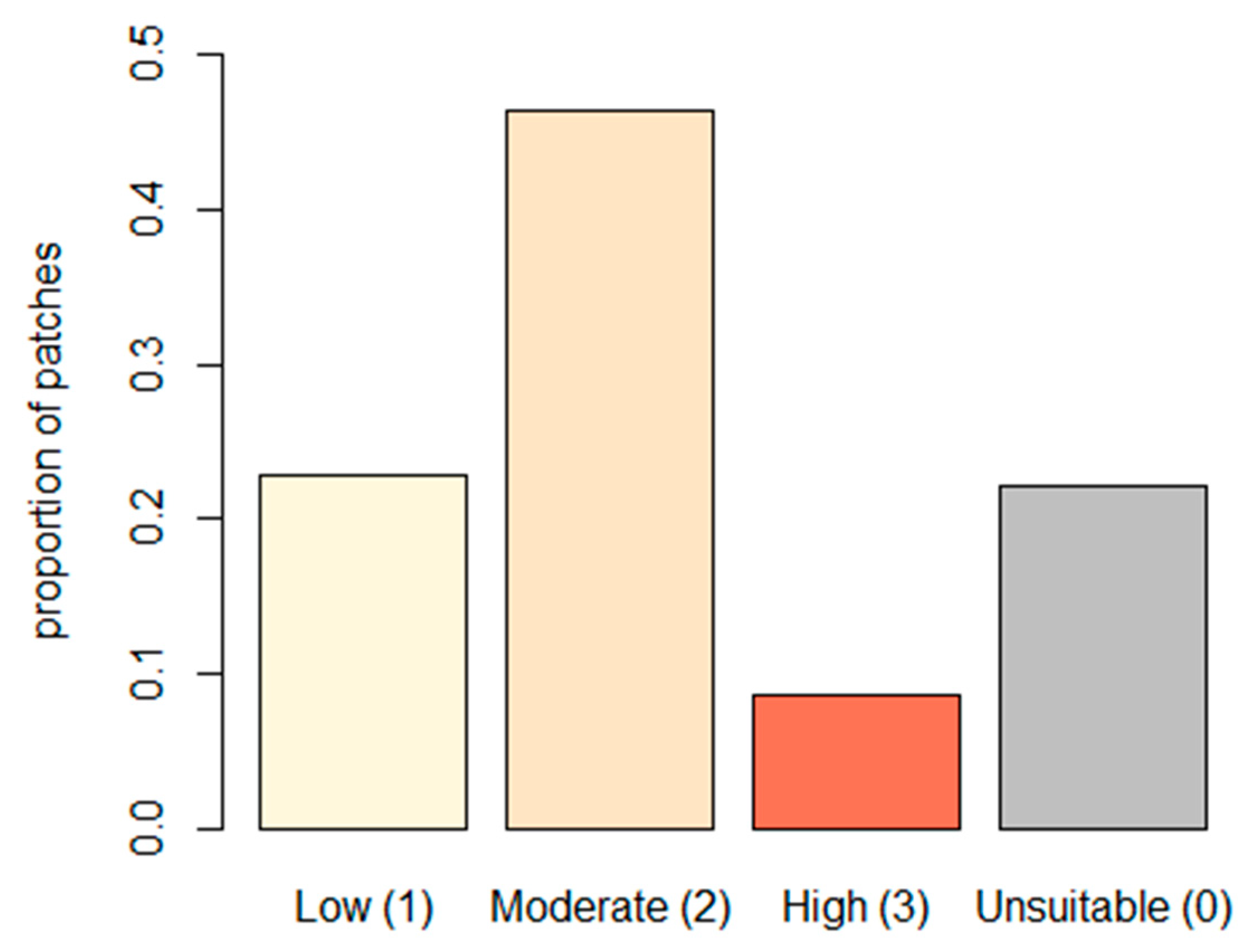
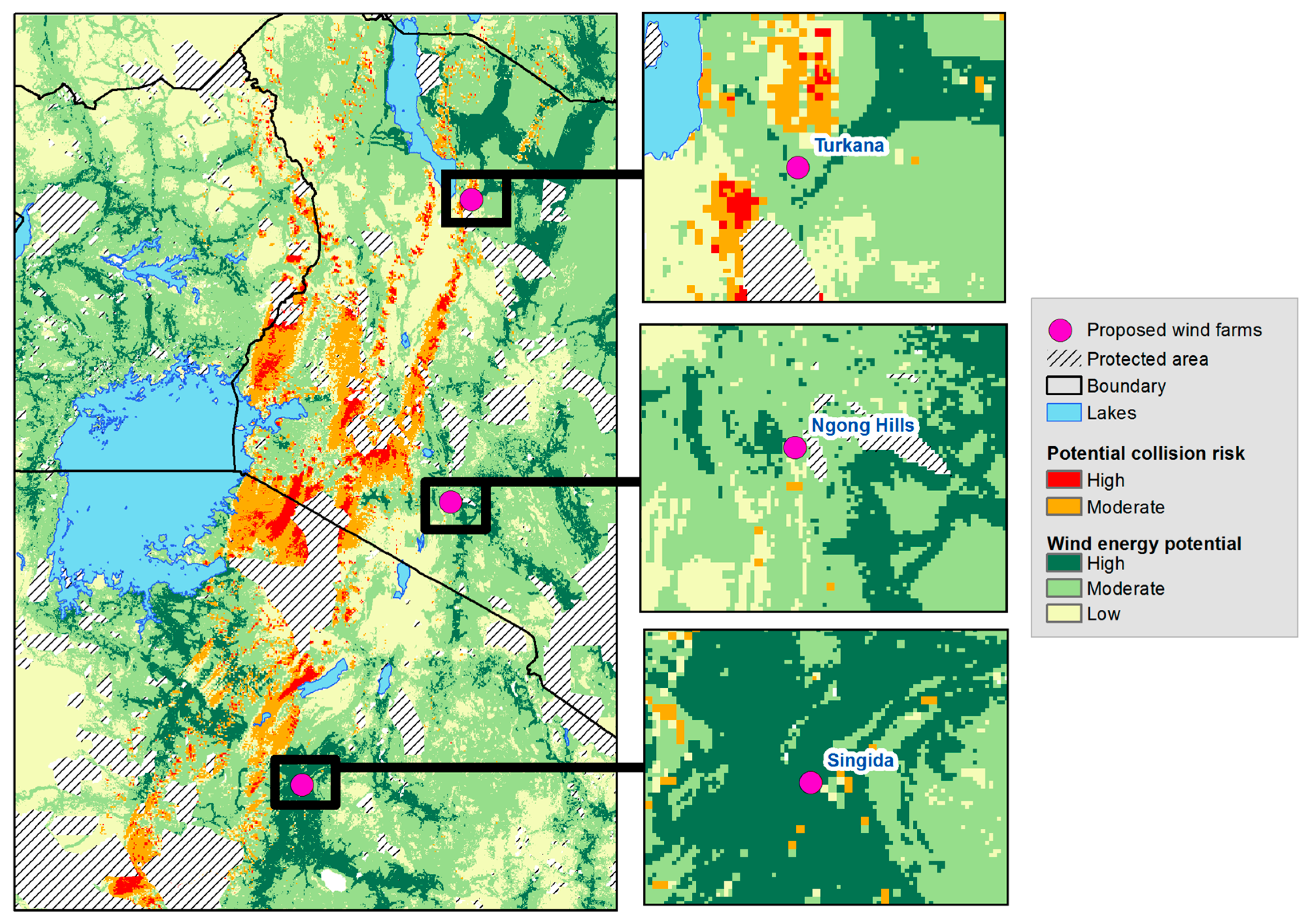
| Type | Data Variable | Data Source | Date |
|---|---|---|---|
| Observed trajectories | GPS trajectories of white storks | Movebank database [45] | 2013–2014 |
| Elevation | Consolidated digital elevation model (DEM) at 1 km resolution | Food and Agricultural Organization (FAO) Geonetwork [47] | 2007 |
| Vegetation index | Normalized Difference Vegetation Index (NDVI) | Moderate Resolution Image Spectroradiometer (MODIS) NDVI [48] | January 2014 |
| Land cover | Land cover classes | European Space Agency (ESA) GlobCover 2009 [49] | 2009 |
| Human population | Population Density | The AfriPop project [50] | 2010 |
| Weather characteristics | Wind speed | European Center for Medium-Range Weather Forecast (ECMWF) reanalysis data [44] | 2006–2017 |
| Wind direction | ECMWF reanalysis data | 2013–2014 | |
| Surface pressure | ECMWF reanalysis data | 2013–2014 | |
| Temperature | ECMWF reanalysis data | 2013–2014 | |
| Sensible heat flux | ECMWF reanalysis data | 2013–2014 | |
| Relative humidity | ECMWF reanalysis data | 2013–2014 | |
| Water bodies | Lakes | Global Lakes and Wetlands Database [51] | 2017 |
| Factors/Suitability Score | Highest (5) | High (4) | Medium (3) | Low (2) | Lowest (1) | Unsuitable (0) |
|---|---|---|---|---|---|---|
| Wind speed (m/s) | >8 | >7–8 | >6–7 | >5–6 | >3–5 | 0–3 |
| Slope (%) | 0–5 | >5–10 | >10–15 | >15–30 | >30–40 | >40 |
| Terrain Roughness Index | Level | Slightly rugged | Intermediately rugged | Moderately rugged | Highly rugged | Extremely rugged |
| Population density (people/km2) | 0–25 | >25–75 | >75–150 | >150–300 | >300–500 | >500 |
| Distance to major roads (km) | 0–1 | >1–2 | >2–5 | >5–10 | >10–20 | >20 |
| Distance to existing transmission lines (km) | 0–5 | >5–10 | >10–15 | >15–20 | >20–30 | >30 |
| Land Cover Class | Suitability Class | Suitability Score |
|---|---|---|
| Irrigated croplands | Lowest | 1 |
| Rain-fed croplands | High | 4 |
| Mosaic croplands/vegetation | High | 4 |
| Mosaic vegetation/croplands | High | 4 |
| Closed to open broadleaved evergreen or semi-deciduous forest | Medium | 3 |
| Closed broadleaved deciduous forest | Lowest | 1 |
| Open broadleaved deciduous forest | Low | 2 |
| Closed needle-leaved evergreen forest | Lowest | 1 |
| Open needle-leaved deciduous or evergreen forest | Low | 2 |
| Closed to open mixed broadleaved and needle-leaved forest | Low | 2 |
| Mosaic forest–shrubland/grassland | Medium | 3 |
| Mosaic grassland/forest–shrubland | Medium | 3 |
| Closed to open shrubland | Low | 2 |
| Closed to open grassland | Highest | 5 |
| Sparse vegetation | Highest | 5 |
| Closed to open broadleaved forest regularly flooded (fresh-brackish water) | Low | 2 |
| Closed broadleaved forest permanently flooded (saline-brackish water) | Low | 2 |
| Closed to open vegetation regularly flooded | Lowest | 1 |
| Artificial surfaces | Unsuitable | 0 |
| Bare areas | Highest | 5 |
| Water bodies | Unsuitable | 0 |
| Permanent snow and ice | Lowest | 1 |
| No data | Unsuitable | 0 |
| Layer | Assigned Weight | Relative Influence (%) |
|---|---|---|
| Wind speed (m/s) | 3 | 25 |
| Slope (%) | 1 | 9 |
| Terrain Roughness Index (TRI) | 1 | 8 |
| Population density (persons/km2) | 1 | 8 |
| Distance to roads (km) | 2 | 17 |
| Distance to existing transmission lines (km) | 2 | 17 |
| Land cover classes | 2 | 16 |
© 2018 by the authors. Licensee MDPI, Basel, Switzerland. This article is an open access article distributed under the terms and conditions of the Creative Commons Attribution (CC BY) license (http://creativecommons.org/licenses/by/4.0/).
Share and Cite
Oloo, F.; Safi, K.; Aryal, J. Predicting Migratory Corridors of White Storks, Ciconia ciconia, to Enhance Sustainable Wind Energy Planning: A Data-Driven Agent-Based Model. Sustainability 2018, 10, 1470. https://doi.org/10.3390/su10051470
Oloo F, Safi K, Aryal J. Predicting Migratory Corridors of White Storks, Ciconia ciconia, to Enhance Sustainable Wind Energy Planning: A Data-Driven Agent-Based Model. Sustainability. 2018; 10(5):1470. https://doi.org/10.3390/su10051470
Chicago/Turabian StyleOloo, Francis, Kamran Safi, and Jagannath Aryal. 2018. "Predicting Migratory Corridors of White Storks, Ciconia ciconia, to Enhance Sustainable Wind Energy Planning: A Data-Driven Agent-Based Model" Sustainability 10, no. 5: 1470. https://doi.org/10.3390/su10051470
APA StyleOloo, F., Safi, K., & Aryal, J. (2018). Predicting Migratory Corridors of White Storks, Ciconia ciconia, to Enhance Sustainable Wind Energy Planning: A Data-Driven Agent-Based Model. Sustainability, 10(5), 1470. https://doi.org/10.3390/su10051470





